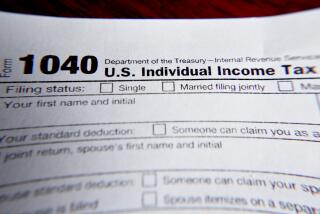Doing Your Taxes? Better Pack a Lunch
- Share via
Getting ready to roll up your sleeves and prepare your federal income taxes? You’d better set aside a chunk of extra time--this year’s more complex tax forms could add nearly four hours to that dreaded job.
The Internal Revenue Service estimates that taxpayers who itemize deductions and report interest and capital gains will need an average of almost 24 hours to handle the task, up from the mere 20 hours it took a year ago.
And much of that extra time will be spent agonizing over convoluted new rules for determining taxable income and credits.
“I don’t know if the average taxpayer can even begin to deal with it,” said Amir Ronen, a tax preparer in Westwood.
All told, the instructions from the IRS coming with the commonly used schedules and with Form 1040--which is used by about half of all taxpayers--come to 107 pages. That’s up from 74 pages a year ago. The IRS also introduced 11 new tax forms and changed 177 others.
Yet the news isn’t all bad for the people expected to file the 126 million individual federal tax returns this year. One of the main reasons: The same changes making taxpayers’ calculations trickier also will bring many of them fatter refund checks.
For some taxpayers, “there’ll be a pot of gold at the end of this,” said David L. Keating, a consultant to the National Taxpayers Union, a nonprofit advocacy group based in Alexandria, Va.
He noted that the IRS announced Thursday that the average refund so far this year--$1,823--is 14% higher than it was for early filers in 1998.
The chief reason for this year’s added complexity are Tax Code changes--many intended to address social needs championed by the Clinton administration--that were passed in 1997 but are just now taking effect.
For instance, some taxpayers now can receive a new credit of up to $400 for children under age 17. Also new are two education credits, the Hope and Lifetime Learning credits. The Hope credit provides up to $1,500 and LifeTime Learning up to $1,000 for tuition and fees for college.
In addition, the alternative minimum tax--intended to prevent the rich from dodging their tax burdens--now will hit more people on somewhat lower rungs of the wealth scale.
Given the frustrations awaiting do-it-yourselfers, many more people this year are expected to buy tax-preparation computer software or to hire accountants or other preparers, such as those with the Kansas City-based H&R; Block chain.
“People will throw up their hands and go to a professional,” Keating said. In other cases, he added, taxpayers will hire professionals because “they’ll be worried about a credit they may have heard about, and wanted to make sure they didn’t miss anything.”
For the professional tax preparer, “there are more lines and forms to navigate, and my guess is that they’ll be charging more because of it,” he added.
People who make a living dealing with taxes, of course, aren’t complaining about the new business. “We’ve become accustomed to this,” said Paul Struhl, a Culver City CPA.
Still, some tax specialists find that the tax law changes are complicating their lives, too. “The clients are very, very interested in the new laws,” said Sylvia Lomas, a tax preparer at H&R; Block in downtown Los Angeles. “I have to go over everything and explain it to them.”
Some taxpayers, on the other hand, shrug off the issue of this year’s tax changes.
“I don’t really notice any difference whatsoever,” said Joel Janda, an investment banker from Westwood. He said that as long as he remains single and has no kids, he expects taxes to remain a snap.
“I bring my taxes to a preparer, but that’s merely a matter of convenience and a lack of time on my part,” Janda said. “It still takes the same amount of time for them this year as it did last, about 45 minutes.”
The estimated increase in the average amount of take it takes to complete the federal tax forms comes from a mathematical formula used by the IRS every year. The formula takes into account everything from photocopying the paperwork and sending it to the IRS to studying the instructions and actually filling out the forms.
Taking all of that into account, the IRS figures that the average taxpayer will take 11 hours and 34 minutes to handle Form 1040, the form that about half of all individual taxpayers submit.
For Schedule A, where you list individual deductions, count on an additional four hours and 28 minutes. Schedule B, used to report interest and dividends, accounts for an hour and 12 minutes.
Then, if you have capital gains to include on Schedule D, figure on another six hours and 41 minutes.
That totals 23 hours and 55 minutes of tax-paying fun, up from 20 hours and six minutes a year ago.
The time estimates “are a lot like those gasoline mileage estimates by the Environmental Protection Agency,” Keating said. “But in this case, it’s your time and frustration that may vary.”
Officials at the IRS, always a target for frustrated taxpayers, are quick to point out that it’s Congress that makes changes in the Tax Code.
“There have been a bunch of tax law changes, and tax changes have to be reflected in the tax forms,” said IRS spokeswoman Michelle Lamishaw.
Recent tax stories as well as forms and links to IRS Web sites can be found at https://www.latimes.com/taxes.
Associated Press was used in compiling this report.
More to Read
Inside the business of entertainment
The Wide Shot brings you news, analysis and insights on everything from streaming wars to production — and what it all means for the future.
You may occasionally receive promotional content from the Los Angeles Times.











